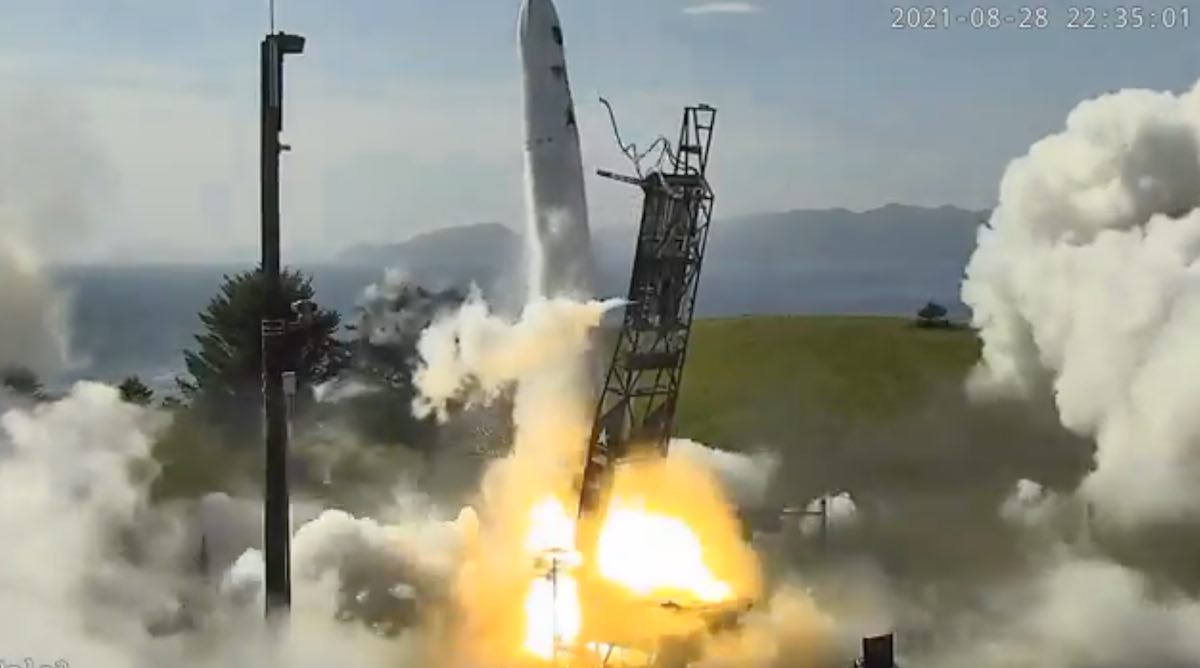
Astra’s small satellite launcher suffered an engine failure just after liftoff from Alaska Saturday, causing the rocket to tilt sideways before recovering and climbing into the upper atmosphere with its four remaining engines. The rocket later veered from its flight corridor, and the range safety officer issued a flight termination command before the mission reached orbit.
The 43-foot-tall (13-meter) rocket, modest by orbital launch vehicle standards, took off from the Pacific Spaceport Complex on Kodiak Island, Alaska, at 6:35 p.m. EDT (2:35 p.m. Alaska time; 2235 GMT) Saturday.
Astra aborted a launch attempt Friday just after ignition of the rocket’s five kerosene-fueled Delphin main engines.
The U.S. Space Force contracted Astra for the test flight Saturday. The military paid for the mission to carry a “non-deployable” payload comprising sensors and instruments to measure the environment satellites would encounter during an Astra launch.
“We regret that we were unable to accomplish all mission objectives for the U.S. Space Force; however, we captured a tremendous amount of data from this test flight,” said Chris Kemp, founder, chairman and CEO of Astra, in a statement. “We will incorporate learnings from this test into future launch vehicles, including LV0007, which is currently in production.”
Hold-down restraints released after engine start Saturday, but one of the Delphin engines shut down less than a second after liftoff, according to Astra, which is headquartered in Alameda, California.
The loss of thrust — a single Delphin engine produces about 6,500 pounds of thrust at sea level — caused the rocket to falter near the launch site. The launch vehicle, designated Rocket 3.3 or LV0006, then flew sideways until the remaining four engines could power the booster into the sky.
In a tweet, Kemp said Astra’s rocket is designed to lift off with a thrust-to-weight ratio of 1.25 to 1. With just four engines firing, the remaining thrust equaled the rocket’s fully loaded weight until the first stage burned off some fuel after a few seconds.
The rocket finally started its upward trajectory, continuing through maximum dynamic pressure — when structural loads on the rocket are highest — and reaching supersonic speeds before a range safety officer on the ground issued a flight termination command about two-and-a-half minutes after liftoff.
Reviewing flight data and video, two things are very clear – 1) An engine shut down right after launch 2) Everything that happened next made me incredibly proud of our team. Space may be hard, but like this rocket, we are not giving up. #AdAstra pic.twitter.com/2g3n812EaW
— Chris Kemp (@Kemp) August 29, 2021
“Everything that happened next made me incredibly proud of our team,” Kemp tweeted. “Space may be hard, but like this rocket, we are not giving up.”
The termination command shut down all four of the remaining Delphin engines, after the rocket apparently deviated from its pre-approved flight corridor.
Astra said the rocket achieve a peak altitude of about 31 miles (50 kilometers) before “safely” falling back to Earth.
The company said it opened a mishap investigation and is working with the Federal Aviation Administration on the inquiry into the cause of the failure.
It was the third orbital launch attempt by Astra, a company hoping to eventually perform daily satellite launches. Astra tried three times last year to launch rockets into orbit, with each attempt getting closer to the goal.
The company’s first orbit-capable rocket, named Rocket 3.0, was supposed to launch in February 2020 in an effort sponsored by the U.S. military’s Defense Advanced Research Projects Agency to demonstrate responsive launch capability. But the mission did not get off the ground before DARPA’s deadline after a series of delays.
Astra intended to try again to launch Rocket 3.0, but the vehicle was destroyed in an accident during a wet dress rehearsal, or fueling test, at Kodiak.
Astra’s first orbital launch attempt Sept. 11, using Rocket 3.1, ended 30 seconds after takeoff when a guidance system problem caused the rocket to drift off course. In response, the rocket’s engines were commanded to shut down and the vehicle fell back to the spaceport on Kodiak Island.
On Dec. 15, Astra’s Rocket 3.2 nearly achieved enough speed to enter orbit. But the upper stage engine shut down just seconds before it was supposed to cut off, leaving the rocket just shy of orbital velocity. The vehicle re-entered the atmosphere, and most of it burned up.
Rocket 3.3, which launched Saturday, debuted several changes to Astra’s design.
It was around 5 feet taller than the rockets Astra used for its first two orbital launch attempts last year. With stretched first stage tanks to hold more propellant, and a lighter upper stage, the new rocket configuration can carry heavier cargo into orbit, according to Astra.
Astra’s rockets are designed to carry small payloads into orbit. The company is pursuing a launch market to deliver CubeSats and,nanosatellites, and microsatellites into orbit.
Astra dispatched Rocket 3.3, known by its serial number LV0006, and fewer than a dozen employees to Kodiak earlier this month to set up the company’s mobile launch infrastructure. A control team working from Astra’s headquarters in California will managed the final launch countdown.
The U.S. Space Force contracted the mission, known as STP-27AD1, with Astra through the Defense Innovation Unit.
“We are thrilled to partner with Astra on this mission and believe this showcases critical low-cost, mobile and responsive launch capability,” said Col. Carlos Quinones, director Department of Defense’s Space Test Program, before the launch.
Astra says it is under contract for a second launch for the Space Force later this year. But that schedule is likely to be determined by the pace of Astra’s investigation into Saturday’s launch failure, and any corrective actions the company introduces to fix the problem.
Email the author.
Follow Stephen Clark on Twitter: @StephenClark1.
